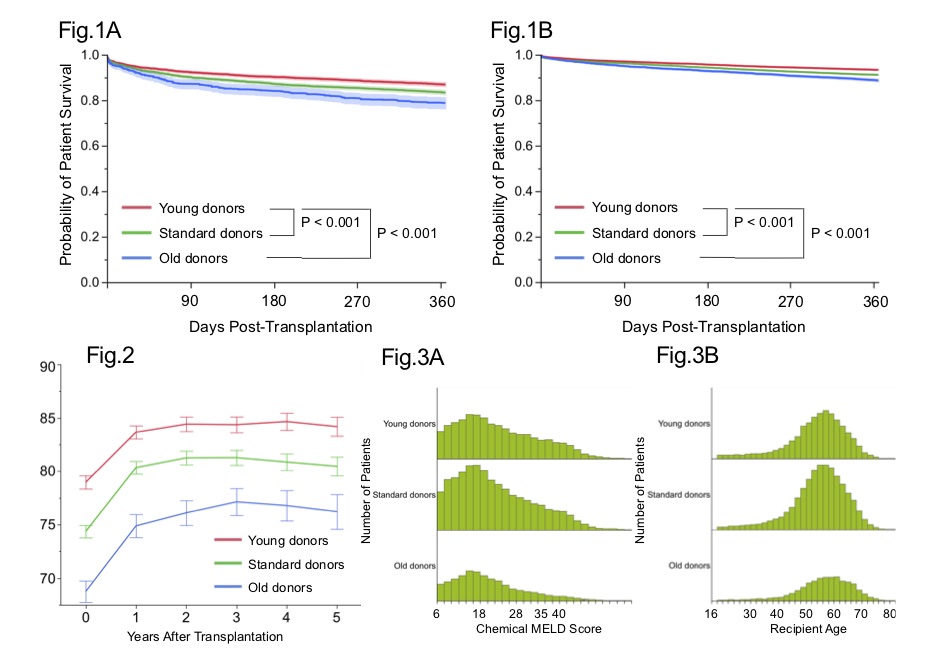The Power of Young Donor Liver; Elixir of Life for Sick Liver Transplant Recipient
J. Kusakabe1, J. McVey2, D. J. Firl2, M. Fujiki2, F. N. Aucejo2, C. Quintini2, K. Hashimoto2, K. Sasaki2
1Kyoto University Graduate School of Medicine, Kyoto, Japan, 2Cleveland Clinic Foundation, Department of General Surgery, Digestive Disease Institute, Cleveland Clinic, Cleveland, OH
Meeting: 2019 American Transplant Congress
Abstract number: C282
Keywords: Age factors, Allocation, Donors, unrelated, Liver transplantation
Session Information
Session Name: Poster Session C: Liver: MELD, Allocation and Donor Issues (DCD/ECD)
Session Type: Poster Session
Date: Monday, June 3, 2019
Session Time: 6:00pm-7:00pm
 Presentation Time: 6:00pm-7:00pm
Presentation Time: 6:00pm-7:00pm
Location: Hall C & D
*Purpose: Young donor organs are known to have significant prognostic benefits in liver transplantation (LT). However, details of short- and long-term prognostic benefits of young donor livers have not been fully investigated. This study aimed to characterize the advantages of young donor use for LT and to assess the efficiency of the actual distribution pattern of young donors.
*Methods: The study included primary adult brain-dead donors between 2002 and 2015 registered in the Scientific Registry Transplant Recipient. Young donors were defined as age 16-35 years old based on growth pattern/age distribution; old donors, as ≥60 based on reported evidence; and the remaining patients, as standard donors. The short-term impact by donor age group was evaluated in terms of 1-year patient survival in low- (<18) and high (>34)-MELD recipients. The long-term impact was evaluated by conditional survival (CS).
*Results: Among 60,726 donors, young/standard/old donors were 21,029/28,725/10,972, respectively. Kaplan-Meier curves showed a significant difference between the groups (P<0.001, respectively) (Fig. 1A, 1B). 1-year survival rates for high-MELD recipients were 86.9/83.3/78.8% for young/standard/old donors, respectively, whereas the rates for low MELD recipients were 93.3/91.1/88.7%, respectively. The relative survival benefits of receiving young organs were 3.6% and 8.1% higher at 1-year in high MELD patients compared to standard and old donors. On the other hand, those benefits decreased to 2.2% and 4.6% in low MELD patients. The CS analysis consistently showed better survival for LT from young donors than from the other groups (P<0.001) (Fig. 2). The probability of surviving an additional 5 years among patients who have survived 1 year, was 83.7/80.3/74.9%, in young/standard/old donors, respectively. Regardless of short and long-term survival benefit, young donor livers were still allocated to low-MELD (40.0%) or old recipients (27.9%) (Figure 3A, 3B).
*Conclusions: The revision of allocation metrics regarding young donor organ is needed to maximize survival benefit per organ.
To cite this abstract in AMA style:
Kusakabe J, McVey J, Firl DJ, Fujiki M, Aucejo FN, Quintini C, Hashimoto K, Sasaki K. The Power of Young Donor Liver; Elixir of Life for Sick Liver Transplant Recipient [abstract]. Am J Transplant. 2019; 19 (suppl 3). https://atcmeetingabstracts.com/abstract/the-power-of-young-donor-liver-elixir-of-life-for-sick-liver-transplant-recipient/. Accessed December 16, 2025.« Back to 2019 American Transplant Congress

